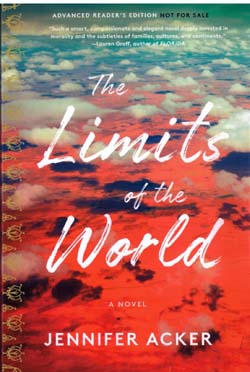The Limits of the World by Jennifer Acker; Delphinium Books © 2019; ISBN 9781883-285777; 300 pages, $25.95.
By Donald H. Harrison

 SAN DIEGO – Immigrants from India found themselves distrusted by both sides of the racial divide in colonial Kenya. As far as black Africans were concerned, the brown-skinned Asians were part of the ruling class, and as far as their white British rulers were concerned, they were part of the underclass. Eventually, Kenya gained independence, and the British administrators moved on. The Indians stayed, often having to face festering resentment.
SAN DIEGO – Immigrants from India found themselves distrusted by both sides of the racial divide in colonial Kenya. As far as black Africans were concerned, the brown-skinned Asians were part of the ruling class, and as far as their white British rulers were concerned, they were part of the underclass. Eventually, Kenya gained independence, and the British administrators moved on. The Indians stayed, often having to face festering resentment.
In this novel, we meet the Chandaria family, who are divided by the oceans and land masses between Nairobi, Kenya, and Columbus, Ohio. Moreover, there is tension in the family derived from Urmila’s regret over having her first son, Bimal, raised by a sister in Kenya. She kept Bimal’s real identity a secret from her second son, the American-born Sunil, who had thought of Bimal as a cousin. Urmila’s husband, Premchand, a medical doctor, meanwhile had little to say in this family drama being a taciturn man who poured himself into his medical practice. Beneath his silence, however, lay great influence.
Two nearly simultaneous events propel this family into crisis. When Bimal is injured, Urmila decides that the family must go to Kenya to tend to him. Just before they leave, Sunil, who is working on a doctoral dissertation in philosophy at Harvard University, marries Amy Kauffman, a Jewish woman whose master’s degree is in the public health field. Afraid that their Jain and Jewish parents will object to their inter-marriage, the couple elopes. The Kauffmans, although newly affiliated with an Orthodox congregation, accept Sunil soon after meeting him. Urmila, on the other hand, is more resistant; she urges her son to dissolve the marriage. Never close to his mother, Sunil rejects her advice. Premchand is far more accepting of Amy.
In Kenya, Amy finds herself a minority within a minority group, often ignored as the women of the family chat in Gujarati. She puts up with the bad manners, knowing that she and Sunil soon will return to the Boston area. While Jewish readers may take special interest in her situation, she is a relatively minor figure in this novel, which focuses more on the Chandaria family’s interactions, especially those between the two newly-discovered brothers on the one hand, and that of the alienated Urmila from nearly everyone, on the other hand. Amy does serve as an important sounding board for Sunil, whose philosophy dissertation struggles with the issue of whether morality is evolutionary, and if so, whether such evolution is universal or differentiated depending on a country and its culture. Amy also is decisive in contrast to Sunil, who suffers from philosophers’ version of writer’s block.
Threaded through the novel is a history of the Indians in Kenya, telling how they arrived; what they did during British colonial times; their situation after independence; and what options they had in a society in which many of them were merchants and professionals, but where they were seen as outsiders – analogous, one might say, to the situation Jews found themselves in many countries of the diaspora.
*
Harrison is editor of San Diego Jewish World. He may be contacted via donald.harrison@sdjewishworld.com